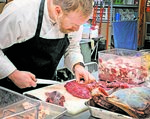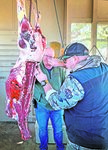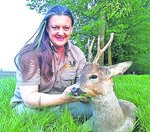


Venison tenderloins and backstraps are the easiest cuts to take from field-dressed deer and are tender and tasty. So much so that they are often cooked in hunt camp the same day the animal is taken. Many hunters then process the rest of the carcass into chili and jerky. There’s nothing not to like about sausage, jerky or a homey bowl of chili, but don’t miss out on the many other delicious ways to prepare game meat.
There are pounds and pounds of cuts from a harvested deer that can become steaks, stews, goulashes and roasts. In order to expand one’s culinary repertoire beyond chili, begin the hunt with the end in mind. Don’t wait until the meat is on the ground to decide what to do with it.
PREPARE TO EAT
All game animals in the U.S. are required to be processed in some way for human consumption, yet they cannot be sold. This means that each hunter either prepares the meat for family and friends or must donate it to be used by one of the many charitable outlets that feed the hungry. More often than not, hunters love spending time in the outdoor or indoor kitchen, transforming their harvest into something delicious to eat. But that meal is the end of a longer process, according to one chef.
Joshua Schwencke, a Texas chef and culinary anthropologist/educator, believes that cooking the harvest begins when one trains the crosshairs on that animal in the field, maybe even before. Through his business and website, gastronomycompany.com, he advocates for both the ethical take and use of the meat.
Schwencke told the Hood County News, “I think it’s the duty of a responsible hunter to see the animal not as a target but as a resource. You must take gratitude out into the field with you. Remember, we are feeding people with this animal which is going to give its life for that. It’s a tangible part of the stewardship of wildlife.”
All hunters know that they are using lethal means to hunt an animal — whether it is gun or bow. While they might be eyeing antler or horn size, hunters should also be mindful of something else. Schwencke said, “Pull the trigger with all the awareness of its culinary potential. Then, when the animal is down, think about how to break it down and bring it to the kitchen to honor and respect that potential.”
TO PROCESS OR NOT
In this view of hunting, one of the first decisions after the kill is whether or not to process the animal yourself. If you have never broken down a whole animal and don’t feel up to the task, make sure you have a pre-selected processor who can handle a variety of cuts, even if their most popular offerings are the chili grind and snack sticks.
Ask the processor, prior to the hunt, if they can produce a crown roast from the deer, elk or antelope you plan to harvest. Can they take a hindquarter and butcher it so you can make some pinwheel steaks? Will there be good chunks for stew meat? Cut the shanks into osso buco? If the answer you receive is “I guess so,” either look for a different processor or learn to butcher the animal yourself.
There are some excellent ways to learn this skill. The Texas Parks and Wildlife Department offers technical courses on game processing as part of its Hunting 101 series. These courses are often at no charge or they might require a minimal fee to participate. Go online to https://tpwd.texas.gov/education/hunter-education/101schedule for more info.
An experienced hunter might be willing to demonstrate the skills for you, or YouTube has been known to teach anything to anybody. Look for a useful video by MeatEater for a step-by-step demonstration of breaking down a deer, from field-dressed to useable components.
Randy Spradlin, an education coordinator for Texas Parks and Wildlife, has advice for the novice: “The cooler you keep the meat, the more hair you keep off the meat, and the sharper your knife, the better off you will be at butchering your animal.”
CHOOSING A RECIPE
When it’s time to choose recipes and cooking methods, Schwencke suggests that “biodiverse animals be prepared in a culinarily diverse way.” What this means is that when you have a variety of species of game, specific cuts of meat require different types of cooking. Slow cooking, braising, frying, grilling – look for recipes suited to the cut of meat you are preparing.
If you don’t eat the backstraps and tenderloins in camp, venison Marsala is a perfect recipe for medallions cut from them. Your favorite chicken fried steak will never taste better than from a butterflied backstrap.
The ham can be prepared in chunks in a rich goulash or slow cooked in a Thai curry sauce. First, sear the outside of chunks of meat and then cook the meat in whatever seasoned liquid with vegetables until tender and savory.
The venison shank can be slow-braised into osso buco with its delicious and distinctive marrow flavor.
Try making stock from the bones. Roast them first for an unmatched richness. Use the stock for a rich soup base for Vietnamese pho. Add in tender slivers of venison to the hot soup just before finishing.
The point is that game meat can be celebrated and relished from field to recipe to table with the utmost culinary respect. Go beyond chili with your next wild game dish.
jay@hcnews.com | 817-573-7066